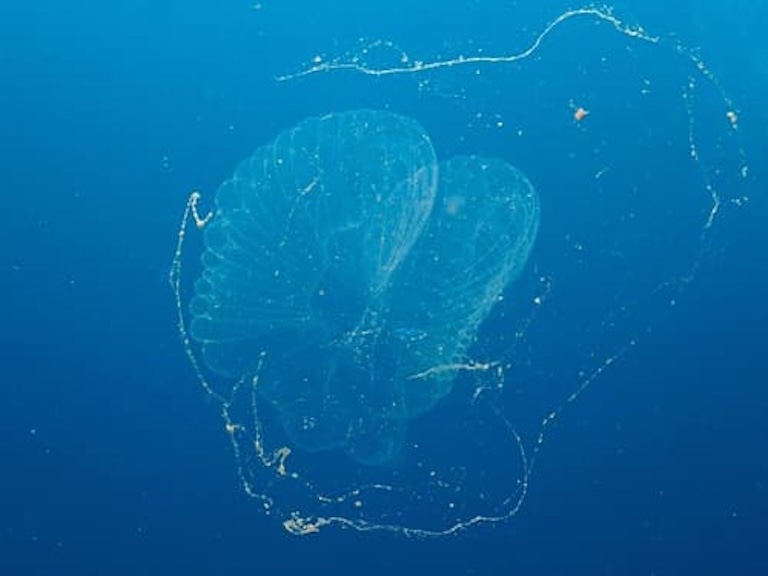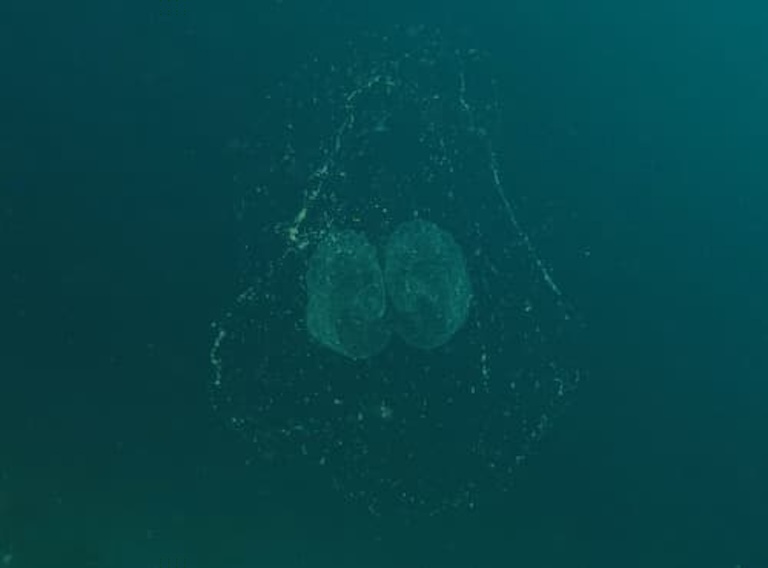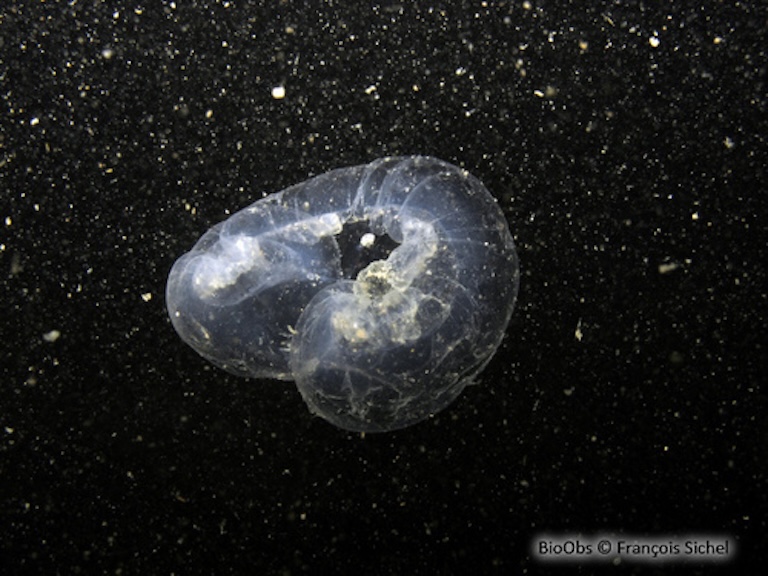Giant Larvacean Profile
While space nerds are spending all their time and money looking for life on sterile clusters of rock in treacherous and inhospitable locations, marine biologists are spending all their time with the aliens that are already here.
And the naming schemes come straight out of the world of fantasy and sci-fi, too.
The leafy sea dragon covers the Tolkien market, but for the Jules Verne fans, we have the Larvaceans, a race of jelly-like animals with surprising family resemblance ties to space nerds.

Giant Larvacean Facts Overview
| Habitat: | Marine |
| Location: | Worldwide |
| Lifespan: | Unknown |
| Size: | 10 cm (3.9 in) long |
| Weight: | Unknown |
| Colour: | Mostly transparent |
| Diet: | Free-floating nutrient matter |
| Predators: | Pretty much everything bigger |
| Top Speed: | Planktonic |
| No. of Species: | Unknown |
| Conservation Status: | Not listed |
Giant larvaceans are so-called because they’re a lot bigger than other larvaceans. And larvaceans are so-called because they never quite mature out of their larval stages.
These chordates have a lot of recognisable anatomy, including a notochord and a rectum, but at first glance, you’re so preoccupied by their intricate mucous houses that you forget all about the rectum entirely.
Despite being found in the topmost layer of most of the ocean on Earth, we still don’t know a whole lot about them, but we do know that their abundance and relentless grazing make them one of the most important animals in the ocean.
Interesting Giant Larvacean Facts
1. They’re bigger than ordinary larvaceans
When the giant larvaceans arrived on Earth (probably in a spaceship) is uncertain, but these soft-bodied filter-feeders share a phylum with all vertebrates, in Chordata.
Larvaceans are members of the tunicate subphylum, containing 3,000 species of what is basically a gel or leathery sac with a pair of siphons for respiration.
Some of these tunicates are commonly known, like the sea squirts and the (forbidden) sea pork, but lesser known are the Appendicularia, or larvaceans, whose taxonomy is a bit opaque, even for gelatinous blobs.
These guys, like most, or perhaps all, tunicates, start life as free-swimming, tadpole-like larvae, but unlike the others, they refuse to grow up, spending their entire lives this way, moving under their own power and probably having a lot more fun that their relatives, who end up permanently affixed to whatever substrate they stick to.
Being chordates, they have a notochord – a spine-like nerve tube, a bit like yours – and this runs all the way down into their flappy little tail.
Most larvaceans are quite tiny, at around 5mm long, so this notochord doesn’t have to go very far, but the giant larvaceans, as the name suggests, can reach a staggering 10 cm long.

2. They’re abundant
Giant larvaceans, in the genus Bathochordaeus, are only one member of the species-rich family Oikopleuridae, which contains at least two subfamilies and several other genera, all of which are free-swimming tunicates.
And they’re found all over the place: Larvaceans as a whole are tremendously abundant, making up the majority of the zooplankton found in the oceans after that of the copepods, and like many copepods (though many also hunt), they’re filter feeders.
3. They make mucous nets
While copepods who filter feed do so with a funny little “flick and wave” strategy to pass water and the tasty bits of dead skin into their feeding receptacles, larvaceans cast a wider net, quite literally.
Larvaceans in general occupy almost all marine water there is, at all depths, but giant larvaceans are more limited to the first 400 metres, and this is where they hang out, casting out webs of sticky mucous, held by complex networks of snot that can span over a metre in diameter.
These delicate masterpieces of phlegm hang in the water column, no doubt enticing all kinds of visitors with their beauty, but certainly snaring fragments of organic matter, phytoplankton and fish poo and so on, which the larvacean readily devours.
Getting a handle on the size and number of these nets, as well as other attributes such as how sticky they are, is the key to understanding how significant these widespread animals are in the ecosystem, but measuring the nets is difficult as they fall apart if anything heavier than a snowflake touches them.
So, this is cutting-edge research, and recent advancements in monitoring technology have already suggested that filtration rates for giant larvaceans exceed that of any other planktonic filter feeder.
So, these little slime webbers are incredibly important parts of the marine food web. 1 2
4. They produce cellulose
Cellulose, the stiff polysaccharide commonly associated with the cell walls of plants, is essentially the plant-based equivalent of chitin, which is found in the hard parts of arthropods, cephalopods and some fish scales.
Cellulose doesn’t come up much in the animal kingdom, other than in the context of special enzymes used to break it down as found in termites and worms, and it’s certainly not often that an animal can produce it.
That remarkable quality is reserved for tunicates, and being a tunicate, it’s a quality that our giant larvaceans make great use of. Along with the mucous membranes secreted to make their feeding nets, cellulose works to support the stretchy attributes with a more protective rigidity.
From this combination, the goo nets are able to form rather intricate and impressive “houses” that surround the animal and help secure its lunch.
House is a good word for it, in many ways, as these tunicates tend to swim around with freeloaders taking advantage of the protection offered by these webs. 3

5. They have a digestive system
While this is a very plant-like behaviour, the giant larvacean is very much an animal, and being a chordate, it’s more closely related to humans than it is to similarly globular animals like jellyfish.
Being almost human, it has a digestive system, and this is important because the gut is the key way to differentiate the families of larvaceans from one another.
Giant larvaceans, being Oikopleurids, have a much longer gut than their sister family Fritillariidae, for example, and this begins with an oesophagus, leading to a wide, two-lobed stomach and a three-chambered intestine culminating in the familiar rectum.
But unlike most of us, their mouths are on their backs and their rectums open on the front. 4
6. We don’t know much else about them
As giant and abundant as these guys are, there isn’t much interest in mucous blobs floating around in the ocean outside of a handful of people who study them as part of the wider picture of marine ecology.
Yet, these are arguably the most important animals in the ocean, and certainly at the foundation of everything larger than they are, most of which either eats them or something that has already eaten them.
But in terms of their life cycles, there isn’t a lot to go on. They’re exceedingly delicate animals, so taking them out of the water is impossible if you want to keep them alive, and studying them in the ocean directly is quite expensive and difficult.
Even taking them out to get a look is difficult, on account of them being almost totally transparent.
Still, their position in the ecosystem hasn’t gone unnoticed, and they even contribute to the protection of ecosystems on land.
7. They’re carbon sequesters
Giant larvaceans may contribute up to one-third of the vertical carbon flux to the deep seafloor. This means if they don’t get eaten, all the junk they collect in their special mucous houses is returned effectively to the sea bed and removed from circulation for the foreseeable future.
As such, they are an essential counter-measure to the release of carbon from the much larger, recently-evolved chordate currently on a murder-suicide rampage on land.
Giant Larvacean Fact-File Summary
Scientific Classification
| Kingdom: | Animalia |
| Phylum: | Chordata |
| Class: | Appendicularia |
| Order: | Copelata |
| Family: | Oikopleuridae |
| Genus: | Bathochordaeus |
Fact Sources & References
- “Blue-tailed giant larvacean”, Monteray Bay Aquarium.
- Katija, K (2017), “New technology reveals the role of giant larvaceans in oceanic carbon cycling”, Sci Hub.
- Keisuke Nakashima (2004), “The evolutionary origin of animal cellulose synthase”, PubMed.
- Brena, C. (2003), “Alimentary Tract of Kowalevskiidae (Appendicularia, Tunicata) and Evolutionary Implications”, Sci Hub.
